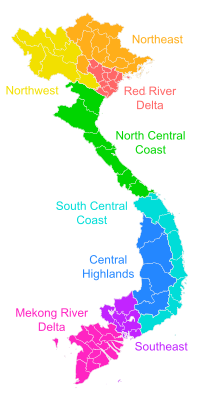Southern Vietnam (Vietnamese: Nam Bộ) is one of the three geographical regions of Vietnam, the other two being Northern and Central Vietnam. It includes 2 administrative regions, which in turn are divided into 19 First Tier units, of which 17 are provinces and 2 are municipalities. In a sub-context, "Southern Vietnam" may include part of Central Vietnam, the two south central costal provinces Ninh Thuận and Bình Thuận are sometimes seen as part of the Southeast region, the Southern. Known as Nam Bộ today in Vietnamese, it was historically called as Gia Định (1779–1832), Nam Kỳ (1832–1945), Nam Bộ (1945–48), and Nam Phần (1948–75).

The origin of Southern Vietnam (Basse-Cochinchine in French, or Lower Cochinchina) was the Kingdom of Funan (from 1st century CE until 6th century CE) and Khmer Empire (from 8th century CE to 17th century). Southern Vietnam was conquered by the Nguyen force in the 17th and 18th centuries from the Khmer kingdom.[1]
The main ethnicities in Southern Vietnam are Kinh, Khmer and Chinese.[2]
Administration
| Administrative region | First Tier units | Area (km2)[3][4] | Population (2022)[3] | Population density (people/km2) |
|---|---|---|---|---|
| Southeast (Đông Nam Bộ, Miền Đông) | Bà Rịa–Vũng Tàu | 23,551.42 | 18,810,780 | 798.71 |
| Mekong River Delta (Đồng Bằng Sông Cửu Long) or Southwest (Tây Nam Bộ, Miền Tây) | An Giang | 40,922.58 | 17,432,120 | 425.98 |
^† Municipality (thành phố trực thuộc trung ương)
See also
- Northern, Central and Southern Vietnam
- Regions of Vietnam
- Six Provinces of Southern Vietnam
- Cochinchina – a historical exonym for South Vietnam
- Champa, ancient coastal states in modern Central and South Vietnam
References
External links
 Southern Vietnam travel guide from Wikivoyage
Southern Vietnam travel guide from Wikivoyage